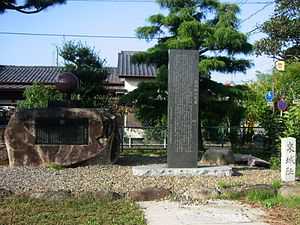Izumi Domain

Izumi Domain (泉藩 Izumi-han) was a feudal domain under the Tokugawa shogunate of Edo period Japan, located in southern Mutsu Province in what is now part of modern-day Iwaki, Fukushima.
History
In 1622, Torii Tadamasa, daimyō of Iwakitaira Domain was transferred to Yamagata Domain, and his place was taken by Naito Masanaga. Masanaga transferred 20,000 koku of his 70,000 koku domain to his eldest son, Naitō Tadaoki who established a separate household. On Masanaga’s death in 1634, Tadaoki inherited Iwakitaira Domain and turned his 20,000 koku holding over to his brother, Naitō Masaharu, who received official confirmation as a daimyō. The marked the start of Izumi Domain. His son, Naitō Masachika ruled from 1646-1696, and also served as wakadoshiyori from 1690-1696. His son, Naitō Masamori was transferred to Annaka Domain in 1702.
Izumi Domain was then assigned to Itakura Shigeatsu, with a reduction in revenues to 15,000 koku. His son, Itakura Katsukiyo served as rōjū and traded places with Honda Tadayuki of Sagara Domain in 1746. The Honda clan continued to rule Izumi domain through the remainder of the Edo period. Tadayuki’s son, Honda Tadakazu caught the eye of rōjū Matsudaira Sadanari after successfully reforming the domain’s finances, and was promoted to wakadoshiyori and sobayonin, where he played an important role in the Kansei Reforms. As a reward for his efforts, his revenues were increased by 5000 koku. The 5th daimyo of Izumi, Honda Tadanori established the domain’s academy in an effort to modernize the domain in the Bakumatsu period. Honda Tadatoshi served as Jisha-bugyō and who led the domain in support of the Tokugawa during the Boshin War. Following the Meiji restoration, he was punished for his support of the Ōuetsu Reppan Dōmei by a reduction in income of 2000 koku, and was forced to resign in favor of his adopted son Honda Tadanobu, who served as domain governor until the abolition of the han system in 1871.
Holdings at the end of the Edo period
As with most domains in the han system, Izumi Domain consisted of several discontinuous territories calculated to provide the assigned kokudaka, based on periodic cadastral surveys and projected agricultural yields.[1][2]
- Mutsu Province (Iwaki)
- 36 villages in Kikuta District
- Kozuke Province
- 9 villages in Seta District
- Musashi Province
- 10 villages in Saitama District
List of daimyo
-
 Naitō clan, 1634-1702 (fudai)[3]
Naitō clan, 1634-1702 (fudai)[3]
# Name Tenure Courtesy title Court Rank revenues 1 Naitō Masaharu ( 内藤政晴)[3] 1634–1645 Hyōbu-shosuke (兵部少輔) Lower 5th (従五位下) 20,000 koku 2 Naitō Masachika ( 内藤政親)[3] 1646–1696 Tamba-no-kami Lower 5th (従五位下) 20,000 koku 3 Naitō Masamori ( 内藤政森)[3] 1696–1702 Tamba-no-kami Lower 5th (従五位下) 20,000 koku
-
 Itakura clan, 1702-1746 (fudai)
Itakura clan, 1702-1746 (fudai)
# Name Tenure Courtesy title Court Rank revenues 1 Itakura Shigeatsu ( 板倉重同) 1702–1717 Iyo-no-kami Lower 5th (従五位下) 15,000 koku 2 Itakura Shigekiyo ( 板倉勝清) 1717–1746 Sado-no-kami; Jiju Lower 4th (従四位下) 15,000 koku
-
 Honda clan, 1746-1871 (fudai)[3]
Honda clan, 1746-1871 (fudai)[3]
# Name Tenure Courtesy title Court Rank revenues 1 Honda Tadayuji ( 本多忠如) 1746–1754 Etchu-no-kami Lower 5th (従五位下) 15,000 koku 2 Honda Tadakazu (本多忠籌) 1754–1800 Danjo-daihitsu (弾正大弼) ; Jiju Lower 4th (従四位下) 15,000 --> 20,000 koku 3 Honda Tadashige (本多忠誠) 1800–1815 Kawachi-no-kami Lower 5th (従五位下) 20,000 koku 4 Honda Tadatomo (本多忠知) 1815–1836 Kawachi-no-kami Lower 5th (従五位下) 20,000 koku 5 Honda Tadanori (本多忠徳) 1836–1860 Etchu-no-kami Lower 5th (従五位下) 20,000 --> 18,000 koku 6 Honda Tadatoshi (本多忠紀) 1860–1868 Noto-no-kami Lower 5th (従五位下) 18,000 koku 7 Honda Tadanobu ( 本多忠伸) 1868–1871 Hyobu-no-suke (兵庫助) Lower 5th (従五位下) 18,000 koku
See also
References
- ↑ Mass, Jeffrey P. and William B. Hauser. (1987). The Bakufu in Japanese History, p. 150.
- ↑ Elison, George and Bardwell L. Smith (1987). Warlords, Artists, & Commoners: Japan in the Sixteenth Century, p. 18.
- ↑ 3.0 3.1 3.2 3.3 3.4 Papinot, Jacques Edmond Joseph. (1906). Dictionnaire d’histoire et de géographie du Japon; Papinot, (2003).
External links
- "Izumi" at Edo 300 (Japanese)
| ||||||||||||||||||||||||||||||||||||||